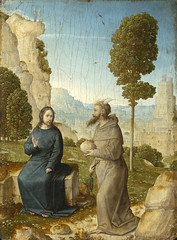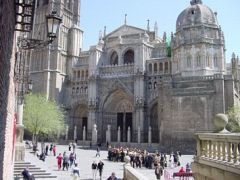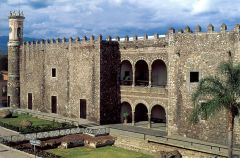![]()
![]()
![]()
Use LEFT and RIGHT arrow keys to navigate between flashcards;
Use UP and DOWN arrow keys to flip the card;
H to show hint;
A reads text to speech;
14 Cards in this Set
- Front
- Back
|
Alhambra 11th century & after Moorish kings Granada, Spain, Iberian Peninsula interior characteristics of Islamic architecture fortress/palace Nasrid Period: Granada is cultural center of Muslim West rooms, courts, fountains, gardens eventual conquest of Peninsula by Northern Christian kingdoms alfiz: adornment, rectangular panel encloses outward side of arch, traditional islamic arch. powerful image of a diminishing kingdom
|

|
|
|
Queen Isabella of Castille unknown, 1490 oil on wood oil painting spread from Northern to Southern Europe portraiture often used for legal purposes (to arrange marriages) Juan de Flandes style |

|
|
|
The Temptation of Christ Juan de Flandes, 1502-03 master of oil on wood, one of his early commissions court artist favored by Isabella "Flandes"=Flanders, netherlandish created for Queen Isabella's private devotions for an alter piece, 1 of 47 panels probably 1 of 2 painters Narrative: 3 temptations, christ is tempted by the devil in each scene retablo: painting rising behind altar of church
|

|
|
|
Monasterio de San Juan de Los Reyes 1477-1504, Toldeo, Spain, Iberian Peninsula monastery built by King Fernando and Queen Isabella to commemorate victory @ Battle of Toro and birth of son architect: Juan Guas example of Gothic style with Spanish/Flemish influences on the Peninsula dedicated to St. John the Evangelist for use by Franciscan friars pointed nave draws eye upward to God side chapels located between butresses |

|
|
|
Zemi figure ca. 1000 Dominican Republic, Taino culture Ironwood, shell Taino=native peoples to the Caribbean "Zemi" is a category of object, like painting or sculpture made in many forms, many materials understood as a symbol of deity/ancestor link to the supernatural world humanoid, crouching posture, exposed teeth, large head cohoba seed crushed onto top plate, inhaled, strong hallucinogen induced visions of other world, ancestors/gods |

|
|
|
Dedication Stone from Templo Mayor 1487, Tenochtitlan, Aztec capital green stone, valued and precious hieroglyphic inscriptions identify figures Aztec kings: Tizoc & Ahuitzotl commemorates last completion of Great Temple figures seen performing auto-sacrifice, piercing bodies to draw blood 8 reed: year corresponds to 1487, depicted in lower half |

|
|
|
Aztec Templo Mayor 1370, Tenochtitlan, Aztec capital center of city, most important rituals and ceremonies took place here 2 stepped pyramids on platform symbolize 2 mountains one is birthplace of war god Huitzilopuch one honors Tlaloc, rain god successive Aztec rulers each enhanced structure by adding a new layer to celebrate them now is a part of historic Mexico city
|

|
|
|
Temple of Sacred Warfare 1507 monument made from volcanic stone complicated relief of symbols of gods, Motchezuma II (aztec king) celebrates triumph of sun and New Fire Ceremony event held every 52 years, important aztec event 2 figures inscribed: Huitzilopchtil & Montezuma II years: 1 rabbit and 2 reeds passage of time is sacred
|

|
|
|
Palace of Cortes 1530, Cuernavaca, Mexico residence of Hernan Cortes, spanish conquistador oldest conserved colonial era structure in the Americas cuernavaca: very fertile land initial structure was a fortess, protection against newly conquered peoples of aztec empire symbol of spanish rule over native peoples loggia is a room open to the air on more than one side
|

|
|
|
Portrait of Viceroy Mendoza unknown, 1535 official viceroy to mexico via spain by King Charles V similar portraiture to isabella of castille, seating behind panel holding book, emotionless
|

|
|
|
Codex Mendoza 1542 codex created by aztecs created 20 years after spanish conquest intended to by seen by king charles V history of aztec empire, conquests contains a list of tributes paid by the conquered description of daily aztec life told through traditional aztec pictogramms named after viceroy mendoza, who may have commissioned it sent on a ship to spain, ship was captured by french folio: method of arranging sheets into book form |

|
|
|
Mass of St. Gregory (featherwork) 1539 feathers & paint on wood made by indigenous feather workers Aztec ruler commissioned piece as a gift for Pope Paul III popular subject in catholic art narrative: pope is is shown giving mass as vision of christ appears on the alter in front of him transubstantiation: bread and wine literally become body and blood os jesus christ passion: christ shows his stigmata and him surrounded by instruments of the passion where he appears to pope |

|
|
|
Church/Monastery @ Huejotzingo 1525 founded by Franciscans to honor St. Michael the Archangel atrium, corner chapels, and main church interior only has one nave simon pereynes: flemish painter created the altarpiece inside |

|
|
|
Inca Cuzco 15th century cusco was the capital of the Inca Empire divided into 4 provinces ceque: roads from center of city went to each province, pathways led out to rest of empire coricancha: inca temple for sun god, most important temple Huacaypata: plaza de arama, main plaza in cusco during inca empire cultural center of empire designed in shape of puma, mythological animal ushnu: pyramid shaped structure used by incas
|

|

